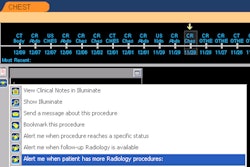In a step that gives clarity to healthcare providers looking to capitalize on federal healthcare IT stimulus funding, the U.S. Centers for Medicare and Medicaid Services (CMS) yesterday published a proposed rule that provides the stage 2 requirements for the government's "meaningful use" program.
And in a positive development for radiology, the rules include criteria for the viewing of images, addressing a noticeable absence in stage 1 meaningful use criteria, which were published in July 2010. Imaging will be one of five menu objectives for eligible professionals in the proposed stage 2 rule, of which three must be met to receive meaningful use funding, the agency said.
The addition of imaging to stage 2 was announced at this week's Healthcare Information and Management Systems Society (HIMSS) meeting by Dr. Farzad Mostashari, national coordinator for health IT at the Office of the National Coordinator for Health IT (ONC).
Under the proposed rule for access to imaging results and information, more than 40% of all scans and tests that result in an image ordered by an eligible professional or authorized provider of the eligible hospital or critical access hospital (CAH) for patients admitted to its inpatient or emergency department during the electronic health record (EHR) reporting period will need to be accessible through certified EHR technology.
CMS defines "accessible" as either incorporation of the image and accompanying information into certified EHR technology, or a prompt in certified EHR technology that the image and accompanying information are available for a given patient elsewhere, the proposed guidance said.
The stage 2 rule also offers guidance on computerized provider order entry (CPOE) for medication, laboratory, and radiology orders. CMS proposes to continue to define CPOE as entailing the provider's use of computer assistance to directly enter medical orders (for example, medications, consultations with other providers, laboratory services, imaging studies, and auxiliary services) from a computer or mobile device; the proposed measure stipulates that more than 60% of medication, laboratory, and radiology orders created are recorded using CPOE, the agency said.
CMS is also considering that a threshold of 10% of all scans and tests also be exchanged with another provider of care.
The proposed rule states that stage 2 requirements will take effect in 2014; final stage 2 rules are expected to be ready by this summer. Another change in this rule is that stage 1 will now continue to be in effect during 2013 and also during a transition phase in 2014.
Imaging will also be included in the proposed 2014 EHR certification requirements, CMS said.
Proponents of radiology were quick to applaud the inclusion of imaging in the stage 2 requirements. The American College of Radiology (ACR) noted that many of the ACR's recommendations were included in the proposed rule, according to Dr. Keith Dreyer, chair of the ACR's IT and informatics committee-government relations subcommittee.
“We are encouraged by early indications from the agencies that many of ACR's various 'asks' have apparently been included to a certain degree,” Dreyer said in a statement.
Provisions advocated by the ACR that were added to stage 2 include more flexibility in the definition of what constitutes "certified EHR technology," measures to promote cancer registry and specialty society registry participation, more information on future penalties for not adopting EHR, clinical quality measures relevant to radiology, and consolidation of patient information provision-related measures, among other criteria.
Dreyer went on to note that the proposed stage 2 rule is only the beginning of the rulemaking process, and the ACR invited its members to offer their input for inclusion in future ACR comments.
“It is important to remember that these proposed rules have a very long way to go in the rulemaking process. Many things can, and will, change before the final rules are promulgated by CMS and ONC later this year,” Dreyer said.




















